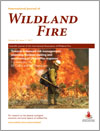International Journal of Wildland Fire
Volume 26
Number 7 2017
Towards Enhanced Risk Management: Planning, Decision Making, and Monitoring of US Wildfire Response
This paper is the preface to a special issue focused on US wildfire response. The nine papers included build from a 2016 conference special session on monitoring, modelling and accountability of fire management policies and practices. Here we provide the unifying theme for these papers, summarise each from this perspective, and conclude with key points emerging from this compilation.
Recent fire science publications reveal a paradigm shift is emerging in response to the growing frequency of large wildland fires and the inherent flaws or failures of fire exclusion exhibited by the ‘wildfire paradox’. A new paradigm of ecological fire management may offer some hope of resolving the paradox.
We review challenges to determining and demonstrating efficiency of strategic approaches to managing low-probability, high-consequence large fire events. Key knowledge gaps relate to quantifying the consequences of fire and how they may change under alternative suppression strategies.
In this paper we present a framework for linking fire weather-derived fire danger indices with field observations of categorical fire behaviour to assess and map the potential for extreme fire behaviour. This approach transforms current and expected fire weather conditions into simple and actionable metrics of fire behaviour risk that wildland firefighters can use to meet required objectives while keeping people safe.
This research supports planning for and management of wildfires to improve resource allocation decisions and to reduce risk to fire responders. We use historical fire perimeters to identify landscape features and conditions associated with where fires stop, and leverage these relationships to predict potential future fire control locations.
United States fire managers were surveyed to assess the operational perception of three key suppression resource themes: importance, scarcity and substitutability.
Large-fire management data are used to examine the relationship between the daily observed percentage of fire perimeter contained and the reported percentage containment during an incident, the incident level exposure index for resources, and resource abundance before and after fire cessation.
Factors associated with daily use of suppression resources on large wildfires are investigated. After controlling for fire, landscape and geographic characteristics, unobserved differences between incident management teams account for ~14% of variation in suppression resources used to manage wildfire incidents.
We developed and implemented a model to improve engine and crew assignments and transfers during a fire season. We implemented this model to study how multiple factors may influence engine and crew transfer costs and efficiencies. Results show we could decrease engine and crew transport costs through efficient resource dispatching.
We examine wildland fire engine assignments in the United States to quantify the effects of regional fire activity, the season and national level resource scarcity on between-region assignment patterns.




